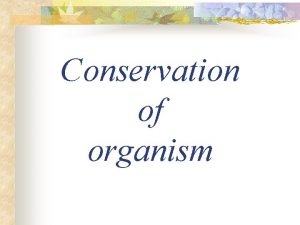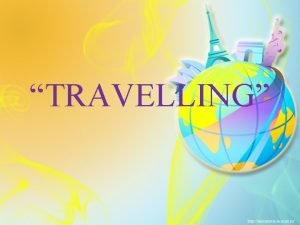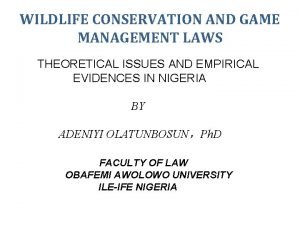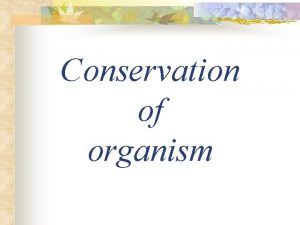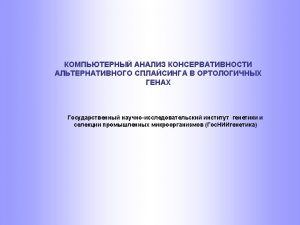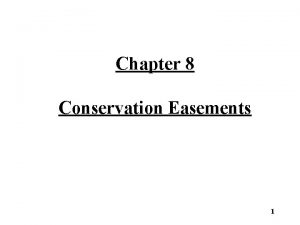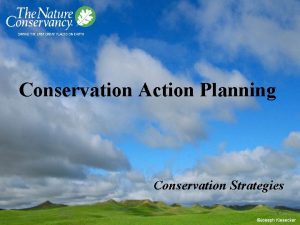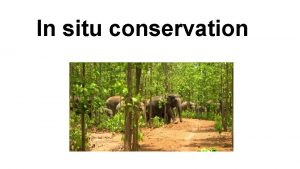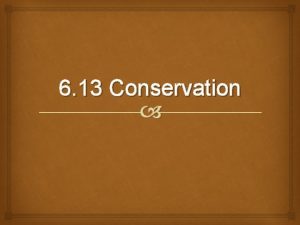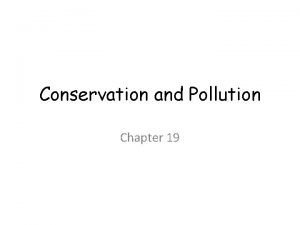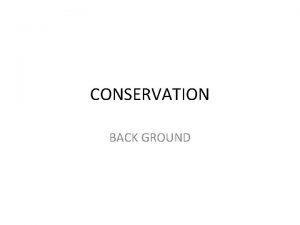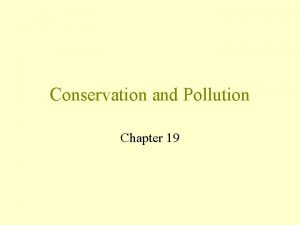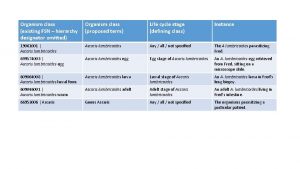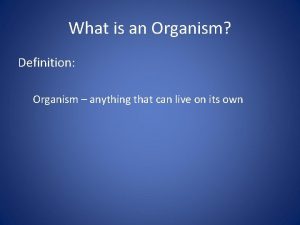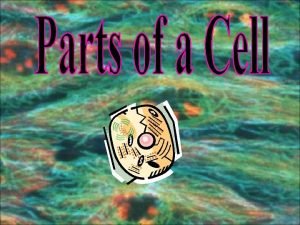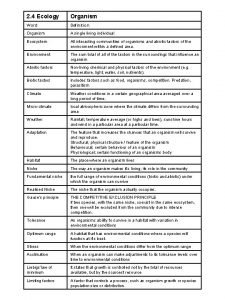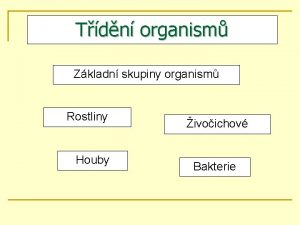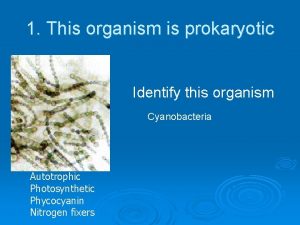Conservation of organism Introduction Nowadays people are more


























- Slides: 26

Conservation of organism

Introduction Nowadays, people are more and more concern about conservation of both environment and organisms. It is because our living environment is more and more polluted, the variety of organisms has decreased drastically. People realize that it will affect our daily lives. Thu, conservation of both environment and organisms are encouraged

Importance of conservation of organisms 1. We rely on organisms as main source of getting energy Human are omnivore. They need to feed on organisms as main source of getting energy. It is because they cannot produce their own food to survive. They need to get energy from organisms to maintain their lives.

2. Losing Strands in the Web of Life It is very difficult to conserve organism on our planet. Especially for the vertebrates, the total number of them declines quickly. Vertebrates include mammals, birds, reptiles, amphibian and fishes. The most significant evidence is that there are many endanger species in the world. More, in 5 million kinds of species of vertebrates, 1/4 will likely to be extinct.

3. Conservation of Biological Diversity If a particular species extinct, its genes will permanently lose. The total pool of genes which life operates is diminished. It will deprive the development of genetic engineering of potential useful genes.

4. Balance the ecosystem If one species (A) extinct, it will have a great effect on the food web. Firstly, the population of the species (B) that A eats will suddenly increase as A will never eat B again. Secondly, another species (C) that feed on A will also be affected. C will be extinct or reduced in population greatly.

5. Organism’s lives should be respected All kinds of organisms have their rights to live on the world. We should not deprive their rights to have their own living style. We must not kill them just because of their valuable fur.

Genetic Conservation Principle: When a particular species becomes extinct, its Genes are permanently lost and the total pool Genes on which life operates is diminished. The potential sources of useful genes lost The genetic heritage decrease

Vanishing Wildlife (now condition) n n Number of people in the world is increasing The land used to build house increase The specific habitats disappeared Nearly all Africa’s elephants will be gone in 20 years

n Data from International Union for Conservation of Nature and National Resources n n n 6, 000 species of organism are in danger 6, 578 species of organism are vulnerable 25, 000 of flowing plant are threatened

Definition of various terms used to describe the status of animals n n Extinct(絕種) -- A species is not definitely located in the wild during the past 50 years Endangered(瀕危) -- A species is in danger of extinction and whose survival is unlikely if the causal factors continue to operate

n n Vulnerable(易危) -- A species is believed likely to move into the 'endangered' category Rare(稀有) -- A species has a small world population that are not at present 'endangered' category

Reasons for conservation 1. 2. 3. 4. Ethical Aesthetic Utilitarian Ecological

1. Ethical n n n religious believes and cultural attitude towards nature is similar some people ague that organism don’t exit for human not for modify purpose all species have right to coexist we don’t have right to cause extinction

2. Aesthetic n n n human derive pleasure from natural environment numerous of organizations promote wildlife, countryside conservation nature permeates art

3. Utilitarian n animal have a lot of contribution n n treat human disease n n e. g. agriculture, fisheries, pollinating insects e. g. about 70% of plants are useful in the treatment of cancer ¼ pharmaceutical come from plant in tropical rainforest

4. Ecological n n benefit both species and human genetic resources maintain the balance of biochemical cycle n n e. g. regulate earth climatic system e. g. plants in tropical rainforest produce 40% of O 2 of the world

Method to prevent extinction n n n protect and restore major habitat establish protecting area e. g. natural parks, topical rainforest control and reduce intensive agriculture reduce use of bio-poisons e. g. pesticide restrict trade in endanger species assist breeding programme establish sperm bank, seed store

Species Conservation in Hong Kong n Today, scientists have described approximately 1. 4 million species of animals and plants. The total of all animals and plant species on Earth is unknown, but is estimated to vary from 5 to 30 million. It is further estimated that 17, 500 species will become extinct every year - which is about one every 30 minutes!

GREEN DRAGON n LONG VALLEY largest remaining freshwater wetland in the northern New Territories where some 210 species of birds, some of which globally rare n the largest in Hong Kong and supports 124 species of reef fish high scientific and educational value n Tung Ping Chau n

n BLUFF ISLAND n an important area for corals and other marine life

CHINESE WHITE DOLPHIN n it is difficult to ignore the ever-present threat of pollution spreading further and further, threatening to consume our marine life as the volume of our contaminants increases

BLACKED-FACED SPOONBILLS(黑 臉 琵 鷺 ) n n It is a 'critically endangered' species --that it is 'facing a very high risk of extinction in the wild in the immediate future' high human populations and associated agricultural and industrial activities, resulting in habitat destruction and pollution

ROMER‘S TREE FROG (盧 文 氏 樹 蛙) n It is an endemic species -- if all the Romer's Tree Frogs in Hong Kong die, this species will become extinct

MACAQUES(獼 猴) n n The overall population macaques, around 800 in 1992, is increasing approximately 10% each year the regular supply of food from visitors had a negative impact on the macaques' behaviour.

BATS n Twenty-one bat species are widespread and common but most of the other species are rare n n The fish-eating habit of Rickett‘s Big-Footed Bat(大 足 鼠 耳 蝠) was only discovered in 1990 in the past five years, two new species (the Eastern Daubenton's and Black-beared Tomb Bats) have been recorded for Hong Kong
 More more more i want more more more more we praise you
More more more i want more more more more we praise you More more more i want more more more more we praise you
More more more i want more more more more we praise you Nowadays people are mỏe
Nowadays people are mỏe Insidan region jh
Insidan region jh School nowadays and in the past
School nowadays and in the past Yellowstone food web answer key
Yellowstone food web answer key Travelling is very popular nowadays.
Travelling is very popular nowadays. Nowadays learning english is very necessary
Nowadays learning english is very necessary Nowadays present perfect
Nowadays present perfect Site:slidetodoc.com
Site:slidetodoc.com Mathematics nowadays
Mathematics nowadays Conservation of biodiversity meaning
Conservation of biodiversity meaning Introduction of wildlife conservation
Introduction of wildlife conservation 5 apples in a basket riddle
5 apples in a basket riddle The more you study the more you learn
The more you study the more you learn Aspire not to
Aspire not to Inertia examples
Inertia examples Knowing more remembering more
Knowing more remembering more The more i give to thee the more i have
The more i give to thee the more i have More choices more chances
More choices more chances Human history becomes more and more a race
Human history becomes more and more a race Who was the long awaited friend of anne why
Who was the long awaited friend of anne why Example of people as media
Example of people as media Where is the love 2016 lyrics
Where is the love 2016 lyrics Transformed people transform people
Transformed people transform people Justpeople
Justpeople Unicellular vs multicellular
Unicellular vs multicellular


